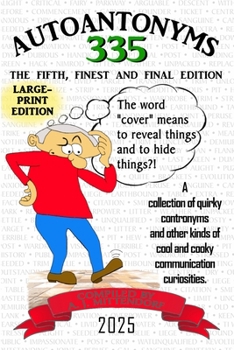Autoantonyms
The first major section of this book opens with 335 examples of autoantonyms, such as "cleave," which can mean "cling to" or "separate from." These are followed by 55 pairs of anti-antonyms-the opposite of autoantonyms. Anti-antonyms are pairs of words that look like they should be antonyms, like "slow up" and "slow down." They are synonyms: two or more words that mean the same thing. Those lists precede "Words with Letters Pronounced Twice" and their opposites, "Words with Ghost Letters," which are followed by "Words Always with Prefixes" and "Words Always with Suffixes." These are followed by seven groups of various types of English redundancies. The second central section includes articles related to the English language. Topics include brief articles on the importance, meanings, or spellings of certain words: "Alright," "Renege," "Ain't," and "Covet," with one article about two words: "Very" and "Extra." It concludes with more significant articles on the Oxford comma and "Y" and "W" as half-vowels in English
Format:Paperback
Language:English
ISBN:1300867957
ISBN13:9781300867951
Release Date:November 2024
Publisher:Lulu.com
Length:266 Pages
Weight:0.79 lbs.
Dimensions:0.6" x 6.0" x 9.0"
Customer Reviews
0 rating





